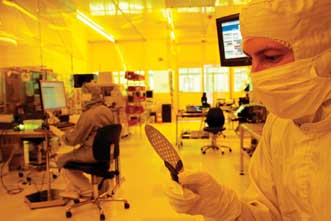
Optical microphone listens with light
A nearly 1-mm-thick optical sensor that measures minute movements and extremely quiet sounds could improve the sensitivity of microphones and give them a sense of direction.
The technology could enable microphones to “see where the sound comes from, pick up the voice of the person speaking, and filter out other sources of noise in the room,” said Matthieu Lacolle, an information and communication technology researcher at SINTEF.

SINTEF has developed a technology that combines two optical phenomena – interference and
diffraction – to make microphones hypersensitive. Photo courtesy of SINTEF.
Its hypersensitivity is based on a combination of two optical phenomena – interference and diffraction. Exploiting these phenomena enabled the researchers to measure movement of less than the diameter of an atom using the sensor.
Special grooved microstructures were created on the reference surface directly beneath the microscope membrane, which picks up pressure waves produced by sound.
“The structures are reflecting metal lines deposited on a transparent substrate and forming a focusing diffractive pattern (basically a diffractive Fresnel lens),” Lacolle told Photonics Spectra.
When illuminated with a vertical-cavity surface-emitting laser, these microstructures can read the direction of reflected light using photodetectors, which transform the light into electrical signals, he said.
“There exist today high-end microphones with such sensitivity, but they are usually bulky and expensive,” Lacolle said. “In essence, everyone who needs a better microphone than a condenser MEMS microphone would benefit from an optical microphone.”
A batch of the devices is currently under fabrication, “and the next step will hopefully be industrialization together with our partners,” he said.
The microphone has garnered a lot of interest for many different industrial applications, Lacolle said. Norwegian noise-measurement equipment supplier Norsonic intends to use the instrument to measure both sound pressure and acoustic power.
Additional applications for the sensor include accelerometers, gyroscopes, vibration and pressure sensors, geophones for seismic shooting, photoacoustic gas sensors, and sensors for highly irradiated sites or areas with electromagnetic radiation.
Published: September 2013